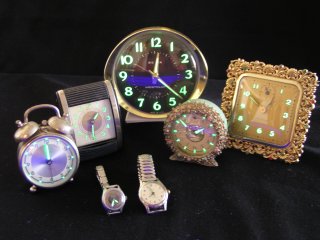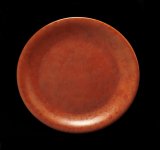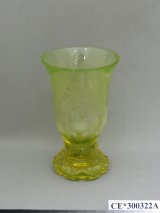
Along with furniture, clothing, jewelry, dishes, and other treasures sold at thrift stores and antique shops, you might find some items that contain radioactive material. Some antiques were made and sold before scientists fully understood the health effects of radiation. Certain radioactive materials were used in antiques because of their unique color. For example:
Radioactive antiques can continue to emit very low-levels of radiation for thousands of years, if not longer. The amount of radiation these items emit is small. However, it can register on a hand-held Geiger counter if the object is close enough to the monitor.
On this page:
Glow-in-the-dark paint is now made without radioactive material, but in the early 1900s radioactive materials were used to make paint that glowed ( radioluminescence The emission of light from objects containing radioactive material, such as radium. ). Radium is one type of radioactive material that could be found in antiques. When radium was discovered in the early 1900s, people were fascinated by the mysterious glow it creates, and it was added to many everyday products, including paints. These paints were used on the dials of clocks and watches to make them glow-in-the-dark. This glow-in-the-dark paint was also used on airplane dials and gauges, which allowed people to read clocks, gauges, and dials at night with no other light.
During World War II, radium dials and gauges allowed pilots to fly at night without cockpit lights. This helped the pilots avoid being seen by enemy soldiers. To create fine tips on their paint brushes for small surfaces, many radium dial painters licked the bristles of their paintbrushes. In doing this, they often swallowed some of the radioactive paint.
However, radium is highly radioactive. It emits alpha, beta, and gamma radiation. If it is inhaled or swallowed, radium is dangerous because there is no shielding inside the body. If radium is inhaled or swallowed, the radiation emitted by the radionuclide can interact with cells and damage them. In the body, radium acts similar to calcium, so the radium that workers ingested was deposited into their bones. Many of these workers developed bone cancer, usually in their jaws. Eventually, scientists and medical professionals realized that these workers' illnesses were being caused by internal contamination from the radium they ingested. These workers have come to be known as "The Radium Girls", and many contemporary history books and movies talk about their experiences. By the 1970s, radium was no longer used on watch and clock dials.

Before the 1970s, many companies used radionuclides to color glazes. The most commonly used radionuclides were uranium, thorium, and potassium. These elements emit alpha, beta and/or gamma radiation.
These glazes can be found on floor and wall tiles, pottery and other ceramics. Uranium was used in the glazes on Cloisonné jewelry to make orange, yellow and green colors. Some Fiestaware produced before 1973 used depleted uranium to create the color of the glaze. Learn more about Depleted Uranium.

For hundreds of years, glassmakers used small amounts of uranium to create yellow or green glass. The yellow tint of this glass led to the nicknames “Vaseline glass” and “canary glass.” Under an ultraviolet (UV) or “black” light, the uranium causes the glass to glow bright green.
After 1970, United States glassmakers and ceramic producers stopped using radionuclides for color. They are still used in a few other countries. Sometimes ceramics and glass with radioactive coloring agents still enter the United States from these countries.
Generally, the federal government does not regulate antiques. However, there are a few exceptions, depending on where the radioactive material came from and the level of radioactivity.
Many states have regulations regarding Naturally-occurring Radioactive Material (NORM), which can regulate processes like the disposal of radium in airplane dials.
State Radiation Protection Programs
The Conference of Radiation Control Program Directors (CRCPD)
This webpage provides links and contact information for each state's Radiation Control Program office.
The NRC establishes regulations for licensing the sale, use, and disposal of radioactive materials. Licensing requirements for the use of radioactive materials in consumer products are based on the quantity and radioactivity of the materials. Generally, the NRC does not regulate antiques, but there are a few exceptions depending on the origin of the radiation source and the source strength.
Exempt Consumer Product Uses of Nuclear Materials
This webpage discusses the NRC's role in regulating radioactive material in consumer products.
The EPA's Superfund program cleans up badly contaminated sites. Contamination at some of these sites includes antiques containing radioactive materials. For example, one cleanup site contained more than one million World War II aircraft gauges with radium dials. Many of these radioactive sources were leaking.
Radionuclide Basics: Radium
This webpage contains basic information about radium, a radioactive element found in some antiques.
Superfund: U.S. Radium Site
This webpage details the EPA Superfund clean up of the U.S. Radium Corporation-site.
The DOE researches radionuclides and radioactivity to understand it better.
Heavy-element chemistry at Los Alamos
This webpage discusses why glass objects containing uranium glow green when exposed to UV radiation from a black light.
The purpose of the Oak Ridge Associated Universities (ORAU) Museum of Radiation and Radioactivity is to chronicle the scientific and commercial history of radioactivity and radiation. The museum’s website shows examples of ways in which radioactive material was added into consumer products throughout history.